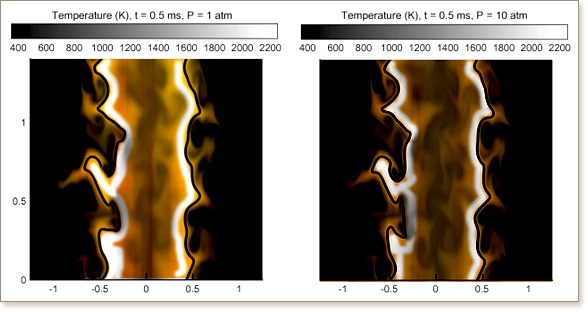

Direct Numerical Simulations of Nonpremixed Ethylene-Air Flames: Local Flame Extinction Criterion
V. R. Lecoustre, P. G. Arias, S. P. Roy, Z. Luo, D. C. Haworth, H. G. Im, T. F. Lu, A. Trouve
Combustion and Flame, 161:2933-2950, (2014)

Direct Numerical Simulations (DNS) of ethylene/air diffusion flame extinctions in decaying two-dimensional turbulence were performed. A Damköhler-number-based flame extinction criterion as provided by classical large activation energy asymptotic (AEA) theory is assessed for its validity in predicting flame extinction and compared to one based on Chemical Explosive Mode Analysis (CEMA) of the detailed chemistry. The DNS code solves compressible flow conservation equations using high order finite difference and explicit time integration schemes. The ethylene/air chemistry is simulated with a reduced mechanism that is generated based on the directed relation graph (DRG) based methods along with stiffness removal. The numerical configuration is an ethylene fuel strip embedded in ambient air and exposed to a prescribed decaying turbulent flow field. The emphasis of this study is on the several flame extinction events observed in contrived parametric simulations. A modified viscosity and changing pressure (MVCP) scheme was adopted in order to artificially manipulate the probability of flame extinction. Using MVCP, pressure was changed from the baseline case of 1 atm to 0.1 and 10 atm. In the high pressure MVCP case, the simulated flame is extinction-free, whereas in the low pressure MVCP case, the simulated flame features frequent extinction events and is close to global extinction. Results show that, despite its relative simplicity and provided that the global flame activation temperature is correctly calibrated, the AEA-based flame extinction criterion can accurately predict the simulated flame extinction events. It is also found that the AEA-based criterion provides predictions of flame extinction that are consistent with those provided by a CEMA-based criterion. This study supports the validity of a simple Damköhler-number-based criterion to predict flame extinction in engineering-level CFD models.